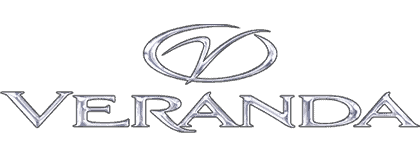Glossary of Terms
Before we can begin to point out the key features of your Veranda Luxury Pontoon, we feel it’s best to first cover some of the basic nautical terms, so you can understand the jargon we use throughout these videos. These terms are also helpful to know when talking to other boaters. Like any pastime, pontoon boating has a distinct culture and special language. While the jargon and insider language of other hobbies and purists may be quirky curiosities, nautical language has a specific purpose and is vital for clear, accurate communication on the open water. The sheer number may be overwhelming for the novice, but picking up a few important nautical terms is a necessary component of proper pontoon boat operation. The following are some of the most common and important terms that every pontoon boat owner should know:
Aft: The back section of your pontoon boat, toward the direction of the stern.
Bilge: The lowest area of a boat where excess water gathers and is subsequently pumped out with proper equipment.
Bow: The front-most area of your pontoon boat.
Burdened: A burdened vessel is a vessel that must yield to another craft.
BWI: Acronym for Boating While Intoxicated. BWIs are the number one cause of boating fatalities in the United States and result in the same penalties on the water as land in most states.
Deck: The floor of your pontoon boat.
Forward: The front section of your pontoon boat, toward the direction of the bow.
Head-On: An event where two vessels approach each other head-on. Neither vessel has the right of way and both should usually pass each other on their port sides.
Helm: The directional control station on your pontoon boat is akin to an automobile’s steering wheel.
Logs: Cylindrical pontoons that provide buoyancy for pontoon boats.
Navigation Lights: All pontoon boats must display lights during nighttime travel to show the size, type, and direction of the pontoon boat.
Making Way: A vessel that is both underways and propelled by an engine or sails.
Mayday: A term used over marine radio frequencies to denote a boat with an extreme emergency, such as a fire or sinking.
Midship: The middle of your pontoon boat.
Not Making Way: A vessel that is adrift, not anchored, and moving due to currents or the wind.
Outboard: A configuration where both the engine and drive are on the exterior of the boat.
Overtaking: An event where one faster boat approaches from a slower boat’s rear. In this situation, the slower craft has the right-of-way.
PFD: Stands for Personal Flotation Device. Law requires that every pontoon boat have at least one PFD per passenger.
Pontoon Boat: A multi-hull vessel that uses hollow cylinders for buoyancy.
Port: The left-hand side of your pontoon boat.
Prop: The pontoon boat’s propeller that provides forward motion.
Restricted Visibility: Rain, snow, or other weather condition that reduces visibility.
Right-of-Way: When encountering another craft, your pontoon boat with right-of-way can continue with its course and speed.
Safe Speed: The maximum speed that a pontoon boat can undertake to ensure no collisions with other vessels.
Stability: A pontoon boat’s potential to handle weight shifts from side to side.
Starboard: The right-hand side of your pontoon boat.
Stern: The rearmost area of your pontoon boat.
Throttle: A hand lever(s) that controls speed and forward or reverse motion.
Underway: A boat in motion, either by deliberate direction or by drifting on a current.
Vessel: Every sort of vehicle, including pontoon boats, whose main mode of transportation involves water.
Visual Distress Signals: Non-electronic signals, such as flags or flares, to draw attention to a vessel.
Wake: The waves that are a result of forward motion of your pontoon boat.
Whistle Signals: Audible signals, made by air or electric horn blasts, to communicate between vessels. All power-driven vessels, such as pontoon boats, are required to use these signals.
Water Stage: The water level and depth of rivers. This varies based on location and season. Also known as a river’s “gage.”
For additional information please reach out to your nearest authorized Veranda dealer or visit www.verandamarine.com.


